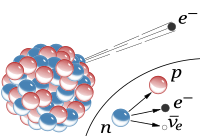
Photo from wikipedia
An overview on the various effects of axial symmetry breaking is presented for medium heavy and heavy nuclei covering the mass number range 70 < A Click to show full abstract
An overview on the various effects of axial symmetry breaking is presented for medium heavy and heavy nuclei covering the mass number range 70 < A <240. The discussion includes various observations for nuclei: level densities, spectroscopic features as energies and transition rates, ground state masses and finally the splitting of giant dipole resonances. Quadrupole moments and rates can be derived from models of triaxial rigid rotation or cranking for a given triaxiality parameters {\gamma}, but microscopic considerations are needed to predict these for each nucleus investigated. Respective predictions were made by recently made Hartree- Fock-Bogolyubov (HFB) calculations extended to arbitrary triaxiality by a generator coordinate method. In accord to these, various observations as reported in this overview demonstrate the importance of allowing a breaking of axial symmetry for heavy nuclei already in the valley of stability. Considering this breaking as indicated from the HFB approach surprisingly many experimental data are well described globally without the need for local fit parameters. In addition to these comparisons it will be shown that it is advantageous to consider c{\gamma}=cos(3{\gamma}) an indicator of axiality for heavy nuclei independent of their quadrupole moment.
Journal Title: Physica Scripta
Year Published: 2018
Link to full text (if available)
Share on Social Media: Sign Up to like & get
recommendations!